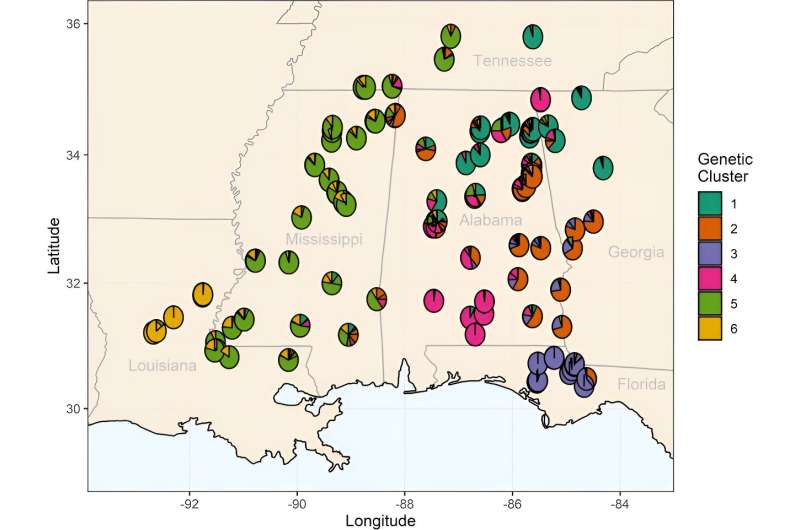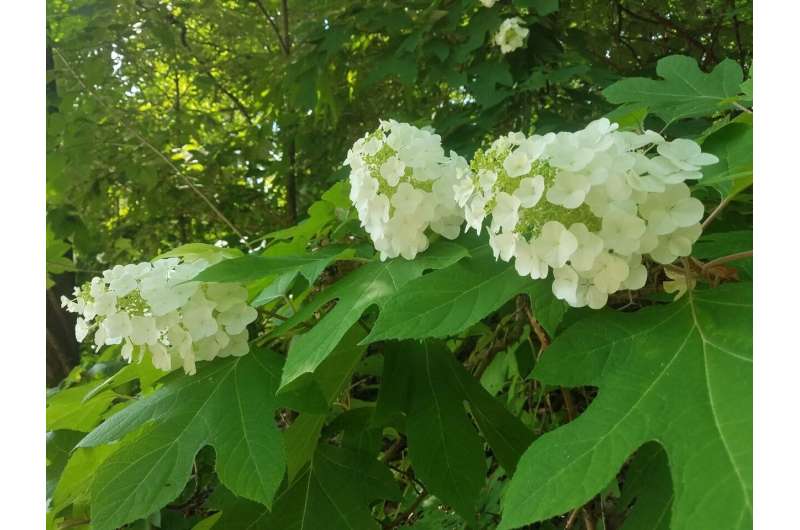This article has been reviewed according to Science X's editorial process and policies. Editors have highlighted the following attributes while ensuring the content's credibility:
fact-checked
peer-reviewed publication
trusted source
proofread
Study: Climate, population structure impact oakleaf hydrangea genetic diversity

Oakleaf hydrangea (Hydrangea quercifolia) is an understory shrub native to the southeastern United States. The species occupies a small native range, and little is known about its demography, genetic diversity, or needs for conservation.
The objectives of a new study of the shrub were to: (1) locate populations of H. quercifolia across its natural range; (2) characterize the genetic diversity of the species and how the diversity is structured; (3) determine the impact that geographic and climatic factors have on this genetic structure; and (4) use this information to identify conservation priorities for the species. Samples were collected from 188 plants in 73 locations throughout the species range and were genotyped by sequencing.
Many historically documented populations were found to be either extirpated or at risk of extirpation. The genetic clusters on the southern extent of the species range are small and contain putative adaptive alleles at relatively high frequencies. These results, published in the Journal of the American Society for Horticultural Science, highlight the importance of preserving representative germplasm from throughout the species range.
Analyses indicate that H. quercifolia exists in six weakly differentiated genetic clusters that are geographically structured. Small population sizes were frequently encountered during sampling, with a few having only a single individual (three populations) and many having fewer than 10 individuals (27 populations). Most of these small populations were on or near the edges of the species range, especially the populations west of the Mississippi River in Louisiana. Many of the populations were very fragmented with little to no connection to other sites with suitable habitat.
An exception to this occurred in northern Alabama, where H. quercifolia grows as nearly continuous populations, often containing hundreds of individuals. Many populations in the southern portion of the species range were growing in calcareous soils; however, a wide range of soil types supporting H. quercifolia populations were observed.

Of the locations where H. quercifolia had previously been documented, 23% (16 of 69 searched) were found to no longer contain populations when searched for in this study. These sites had either undergone land use change (housing developments, clear cutting, roadside vegetation control) or habitat degradation due to logging or invasive species. The primary species noted was Ligustrum sinense. Observations during sampling indicate that H. quercifolia does not tolerate high competition. Many of these extirpated populations were located on the edges of the species range.
Based on the observations of extirpated populations occurring primarily on the edges of the species range, it appears the range for H. quercifolia is currently shrinking. Therefore, U.S. populations on the edges of the species range should be of conservation concern, especially those in Louisiana west of the Mississippi River and in Florida.
Environmental association analysis suggests that several climatic variables significantly affect genetic diversity, with precipitation being the primary environmental factor affecting genetic variation in H. quercifolia. Furthermore, the analysis identified candidate locations for environmental adaptation for both precipitation and temperature variables.
According to Dr. Alexander, "All of us were interested in the conservation, genetics, and breeding of woody ornamental shrubs. Oakleaf hydrangea is a native shrub, but not much is known about its current status in the wild or the range of genetic diversity that exists in wild populations We are continuing to observe seedlings from these populations for important horticultural traits with the goal of improving and promoting oakleaf hydrangea as a native landscape plant."
Dr. Alexander is a research geneticist with the USDA–ARS U.S. National Arboretum, Nursery Research Center in Tennessee. She conducts research to develop, evaluate, and release improved germplasm of selected nursery crop species, including, but not limited to, Hydrangea, Osmanthus, and Callicarpa, and use genetic markers to accelerate the breeding process.
More information: Andrew Sherwood et al, Precipitation, Temperature, and Population Structure Influence Genetic Diversity of Oakleaf Hydrangea Throughout Its Native Range, Journal of the American Society for Horticultural Science (2023). DOI: 10.21273/JASHS05255-22
Journal information: Journal of the American Society for Horticultural Science
Provided by American Society for Horticultural Science


















